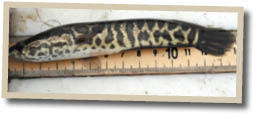Invasive Species
Did you know it is illegal to transport an invasive species alive? Please help us track invasive fish by killing and reporting your catch at http://bit.ly/reportinvasivefish or use your phone to scan the QR code!
Flathead Catfish
Flathead catfish are most easily recognized by their broad, flat head, brown mottled coloration and lower jaw which sticks out further than the upper.

Blue Catfish
The invasive blue catfish (on top), and a channel catfish (lower) can be differentiated by spreading out the anal fin and looking for a straight or lobed appearance.

Northern Snakehead (Mature)
Northern snakehead are identified by a long dorsal (back) fin and anal fin, a rounded tail, and a large mouth reaching beyond the eye with many, sharp teeth. They are often confused with native bowfin. Visit http://fishspecies.dnrec.delaware.gov for more identification information.

Northern Snakehead (Juvenile)



